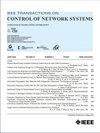联合失败:关于多重和多层网络博弈的纳什均衡
IF 5
3区 计算机科学
Q2 AUTOMATION & CONTROL SYSTEMS
引用次数: 0
摘要
网络游戏为研究战略决策过程提供了一个框架,而战略决策过程是由代理之间的结构性相互依赖关系所控制的。然而,现有的模型没有考虑代理同时在多个网络上交互的环境,或者代理在多个动作维度上操作的环境。在这篇文章中,我们提出了新的多重网络博弈模型来捕捉战略代理之间不同的交互模式,以及多层网络博弈模型来捕捉它们在多个行动维度上的交互。我们探讨了多路/多层网络的组成网络的属性如何破坏或支持博弈纳什均衡的存在性、唯一性和稳定性。值得注意的是,我们强调了组成网络的最大和最小特征值(分别反映了它们的连通性和双面性)有助于确定多路/多层网络博弈平衡的唯一性。综上所述,我们的研究结果揭示了个体在网络网络中相互作用时平衡脆弱性的原因,并指出了缓解这种脆弱性的潜在干预措施。本文章由计算机程序翻译,如有差异,请以英文原文为准。
United We Fall: On the Nash Equilibria of Multiplex and Multilayer Network Games
Network games provide a framework to study strategic decision-making processes that are governed by structured interdependencies among agents. However, existing models do not account for environments in which agents simultaneously interact over multiple networks, or when agents operate over multiple action dimensions. In this article, we propose new models of multiplex network games to capture the different modalities of interactions among strategic agents, and multilayer network games to capture their interactions over multiple action dimensions. We explore how the properties of the constituent networks of a multiplex/multilayer network can undermine or support the existence, uniqueness, and stability of the game's Nash equilibria. Notably, we highlight that both the largest and smallest eigenvalues of the constituent networks (reflecting their connectivity and two-sidedness, respectively) are instrumental in determining the uniqueness of the multiplex/multilayer network game's equilibrium. Together, our findings shed light on the reasons for the fragility of equilibria when agents interact over networks of networks, and point out potential interventions to alleviate them.
求助全文
通过发布文献求助,成功后即可免费获取论文全文。
去求助
来源期刊

IEEE Transactions on Control of Network Systems
Mathematics-Control and Optimization
CiteScore
7.80
自引率
7.10%
发文量
169
期刊介绍:
The IEEE Transactions on Control of Network Systems is committed to the timely publication of high-impact papers at the intersection of control systems and network science. In particular, the journal addresses research on the analysis, design and implementation of networked control systems, as well as control over networks. Relevant work includes the full spectrum from basic research on control systems to the design of engineering solutions for automatic control of, and over, networks. The topics covered by this journal include: Coordinated control and estimation over networks, Control and computation over sensor networks, Control under communication constraints, Control and performance analysis issues that arise in the dynamics of networks used in application areas such as communications, computers, transportation, manufacturing, Web ranking and aggregation, social networks, biology, power systems, economics, Synchronization of activities across a controlled network, Stability analysis of controlled networks, Analysis of networks as hybrid dynamical systems.
 求助内容:
求助内容: 应助结果提醒方式:
应助结果提醒方式:


